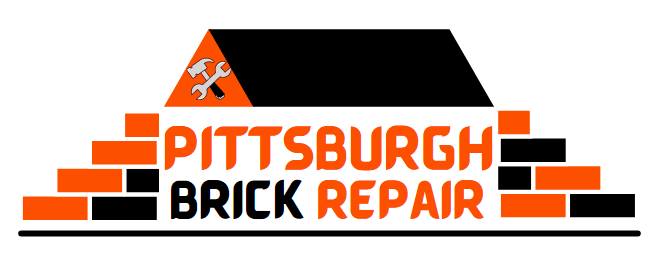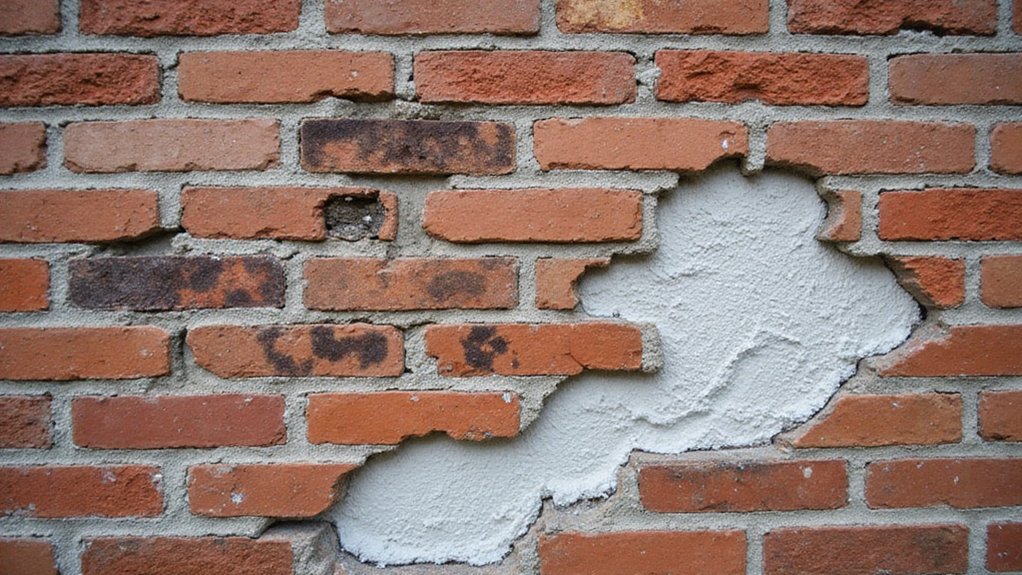If you’ve ever noticed strange white streaks, crumbling mortar, or damp patches on your brick walls, you’re witnessing moisture’s silent assault. Water isn’t just a passive element—it’s a destructive force that can gradually compromise your home’s structural integrity. Understanding how moisture infiltrates and damages brick surfaces isn’t just technical knowledge; it’s your first line of defense against potentially costly repairs. Curious about safeguarding your walls? Let’s investigate the hidden risks lurking beneath the surface.
Types of Moisture Damage in Brick Walls
When moisture infiltrates brick walls, it can lead to various types of damage that compromise the structural integrity and appearance of your home. You might notice efflorescence formation, which appears as white, powdery salt deposits on your wall’s surface.
Rising damp issues can also develop, causing paint to bubble and walls to feel damp or cold. These moisture problems can weaken your bricks, create unsightly stains, and potentially lead to mold growth.
Understanding these signs early can help you protect your home and prevent costly repairs down the line. Tuckpointing services can help address mortar deterioration caused by water damage and prevent further structural issues.
Signs of Water Intrusion and Degradation
Water intrusion in brick walls manifests through several telltale signs that can alert homeowners to potential structural damage. You’ll want to watch for these critical indicators of moisture problems:
- Visible efflorescence (white, powdery salt deposits on wall surfaces)
- Crumbling mortar between bricks
- Dark or discolored patches indicating water absorption
- Soft or deteriorating brick surfaces
These signs suggest your brick walls are experiencing significant water-related stress. Left unchecked, moisture can compromise your home’s structural integrity, leading to expensive repairs. Tuckpointing professionals can help prevent further damage by addressing mortar deterioration caused by wind and moisture before it leads to serious structural issues.
How Ground Moisture Impacts Brick Structures
Soil’s hidden moisture can be a silent threat to your brick home’s foundation, gradually compromising its structural stability. Ground moisture creates hydrostatic pressure that pushes against your foundation walls, causing potential cracking and weakening.
Through capillary action, water can climb up porous brick surfaces, bringing minerals and causing gradual deterioration. This moisture movement can lead to efflorescence, where white salt deposits appear on your walls, signaling underlying water penetration issues.
Understanding these moisture flows helps you protect your brick structure’s long-term integrity.
The Role of Humidity and Condensation
Beyond ground moisture, atmospheric conditions play a significant role in brick wall deterioration. Humidity and condensation can silently damage your walls, creating hidden risks you’ll want to address quickly.
Key humidity challenges include:
- High indoor humidity promotes mold growth
- Condensation can weaken mortar joints
- Temperature differences trigger moisture buildup
- Vapor barriers become critical in prevention
Proactively monitoring moisture levels helps protect your home’s structural integrity. Professional moisture monitoring techniques can detect early warning signs before serious damage occurs. By understanding these atmospheric fluctuations, you’ll safeguard your brick walls against potential long-term deterioration.
Preventing Water Penetration Techniques
Several strategic techniques can help homeowners protect their brick walls from destructive water penetration. You’ll want to start by applying high-quality vapor barriers that shield your walls from moisture intrusion.
Professional sealant applications can create an additional protective layer, preventing water from seeping into tiny wall cracks. Consider working with experienced contractors who understand moisture fluctuations and can recommend the most effective waterproofing methods for your specific brick structure. By taking proactive steps, you’ll safeguard your home’s integrity and prevent costly water damage.
Waterproofing Solutions for Brick Walls
When water threatens your brick walls, waterproofing becomes your primary defense mechanism against potential structural damage. Protecting your home requires strategic solutions that shield your exterior from moisture invasion.
Effective waterproofing strategies include:
- Applying specialized exterior wall coatings
- Installing internal drainage systems
- Sealing visible cracks and joints
- Regular professional inspections
Professional-grade sealants and protective treatments can extensively reduce water penetration risks. You’ll want to choose products specifically designed for brick surfaces, ensuring long-lasting protection against moisture-related deterioration. By investing in thorough waterproofing, you’re safeguarding your home’s structural integrity and preventing costly future repairs.
Repair and Restoration of Moisture-Damaged Brickwork
Water’s silent assault on brick walls can alter a minor moisture issue into a structural nightmare. When waterborne salts penetrate your brickwork, they can cause significant damage, weakening the wall’s integrity.
Brick repointing becomes essential in restoring your wall’s strength and preventing further deterioration. You’ll want to carefully remove damaged mortar, clean the brick surfaces, and replace the old mortar with a compatible, water-resistant mixture.
Professional restoration experts can help you identify the extent of damage and recommend the most effective repair strategies. Don’t let moisture compromise your home’s structural foundation.
Maintenance Strategies to Protect Brick Surfaces
Because moisture can quickly deteriorate brick surfaces, homeowners must proactively implement strategic maintenance techniques to protect their masonry investments. Regular care prevents costly repairs and preserves your home’s structural integrity.
Key maintenance strategies include:
- Perform periodic inspections twice yearly
- Seal small cracks immediately
- Guarantee proper drainage around foundation
- Schedule professional assessments annually
Professional evaluations help identify potential moisture vulnerabilities before they become significant problems. By staying vigilant and addressing issues promptly, you’ll safeguard your brick walls against water damage, maintaining their appearance and structural strength for years to come.
Frequently Asked Questions
Can Moisture Damage Happen Quickly or Is It a Gradual Process?
Moisture damage can strike suddenly, especially when sudden temperature changes and improper ventilation systems create perfect conditions. You’ll notice gradual deterioration if you don’t address these environmental factors quickly.
How Expensive Are Professional Brick Moisture Repair and Waterproofing Services?
Professional brick moisture repair can range from $500 to $5,000, depending on damage. You’ll save money by choosing budget-conscious alternatives and implementing cost-effective prevention methods before extensive repairs become necessary.
Will Homeowner’s Insurance Cover Water Damage to Brick Walls?
Your insurance policy may cover water damage to brick walls, depending on the cause. Check your homeowner’s claims process, as sudden accidents are typically covered, but gradual moisture issues often aren’t.
Are Some Brick Types More Resistant to Moisture Than Others?
You’ll find some brick types resist moisture better due to their porosity variations and weathering resistance. Dense, fired clay bricks with low water absorption rates will protect your home more effectively against moisture damage.
Can DIY Solutions Effectively Prevent Moisture Damage in Brick Walls?
You can protect your brick walls through strategic DIY drainage installations and interior climate control. These proactive measures help prevent moisture damage, preserving your home’s integrity and creating a sense of long-term security.

